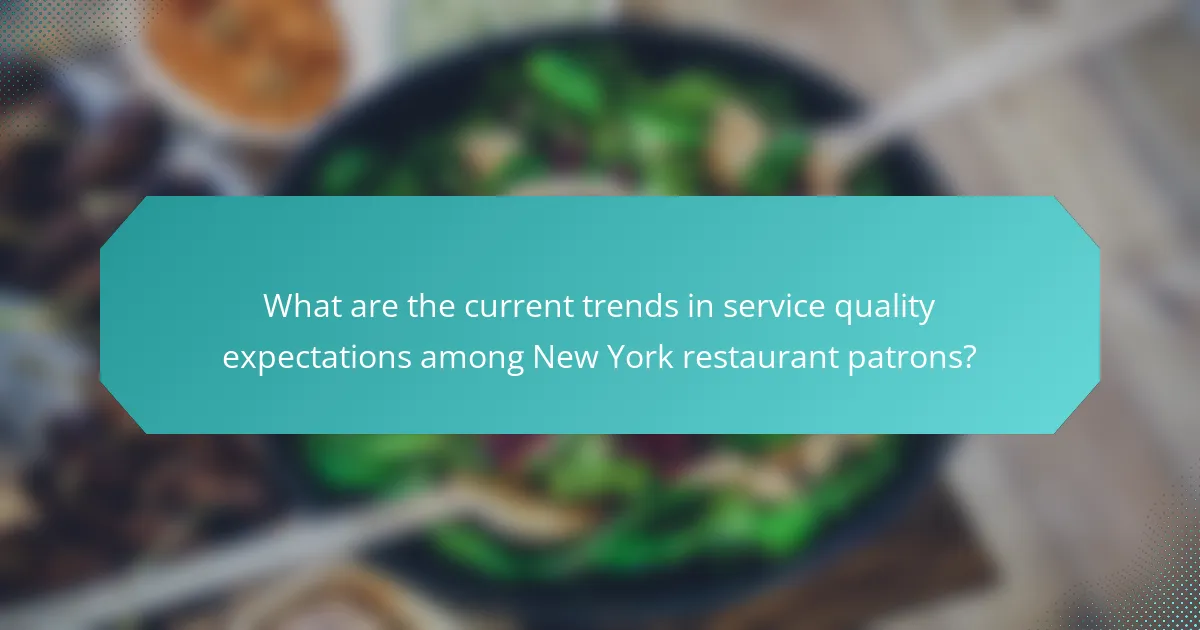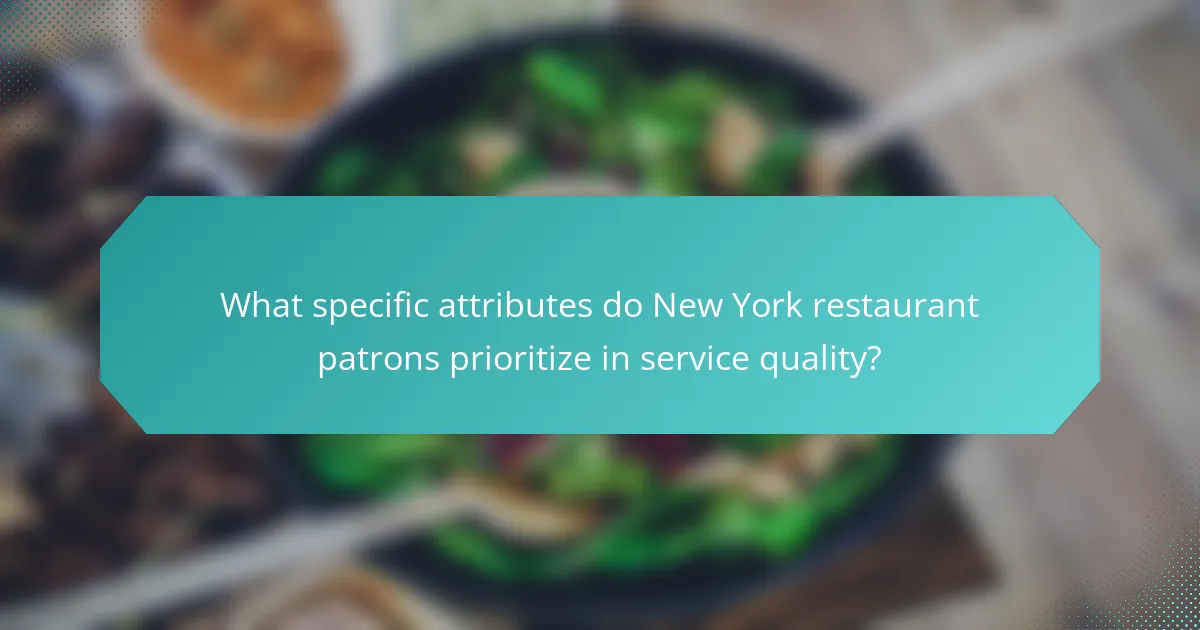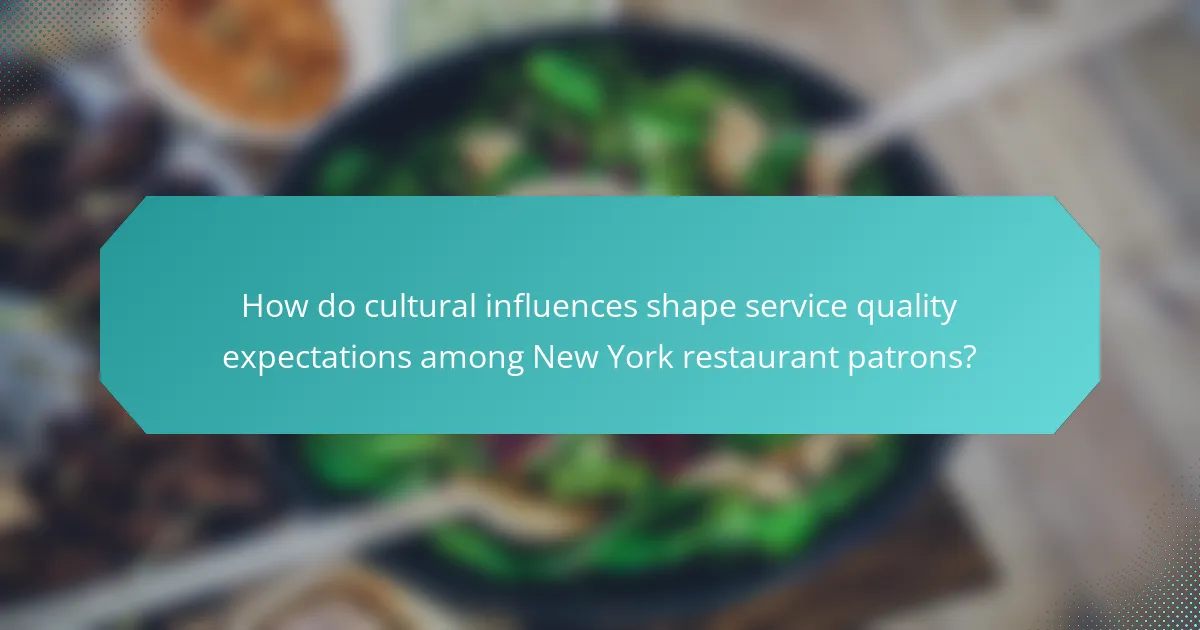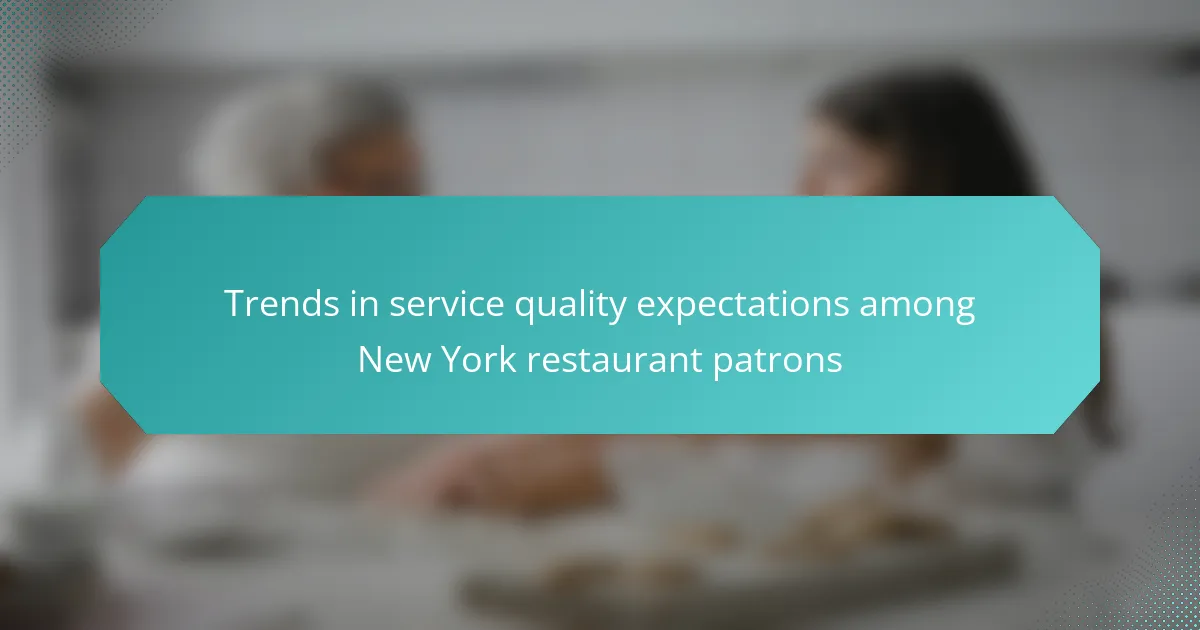The article examines current trends in service quality expectations among New York restaurant patrons, highlighting key attributes such as personalized experiences, efficient service, and cleanliness. Patrons increasingly prioritize attentive staff who can provide tailored recommendations and quick food delivery, reflecting a shift towards a customer-centric approach. Cultural influences play a significant role in shaping these expectations, with diverse backgrounds leading to varying preferences for service speed and attentiveness. Additionally, the integration of technology and transparency in ingredient sourcing are becoming essential factors in dining decisions. Recent surveys indicate that service quality is a crucial determinant for 70% of diners in New York’s competitive restaurant landscape.

What are the current trends in service quality expectations among New York restaurant patrons?
Current trends in service quality expectations among New York restaurant patrons emphasize personalized experiences and efficient service. Patrons increasingly seek attentive staff who can provide tailored recommendations. Quick service remains a priority, with many diners valuing timely food delivery. Cleanliness and safety standards have become non-negotiable due to heightened health awareness. Additionally, the integration of technology, such as mobile ordering and contactless payments, is expected. Transparency in ingredient sourcing and sustainability practices also influence customer preferences. Recent surveys indicate that 70% of diners prioritize service quality as a key factor in their dining decisions. These trends reflect a shift towards a more customer-centric approach in the restaurant industry.
How have service quality expectations evolved in recent years?
Service quality expectations have significantly increased in recent years. Customers now demand faster service and personalized experiences. The rise of technology has made real-time communication essential. Patrons expect staff to be knowledgeable and attentive. Social media influences perceptions of service quality. Online reviews shape customer expectations before dining. A 2021 survey indicated that 78% of diners prioritize service speed. Overall, a heightened awareness of service quality is evident among New York restaurant patrons.
What factors have contributed to changes in service quality expectations?
Changes in service quality expectations are influenced by several key factors. Technological advancements have increased customer access to information and service options. This access leads to higher expectations for service speed and efficiency. Social media has amplified customer voices, allowing for immediate feedback and reviews. Consequently, restaurants must maintain high service standards to avoid negative publicity. Globalization has exposed patrons to diverse dining experiences, raising their standards. Additionally, shifting consumer demographics and preferences demand personalized service. Economic factors also play a role; during economic growth, patrons expect premium service. These combined factors create a dynamic environment where service quality expectations continuously evolve.
How do demographic shifts influence these expectations?
Demographic shifts significantly influence service quality expectations among New York restaurant patrons. Changes in age, income, and cultural backgrounds alter what patrons prioritize in their dining experiences. For example, millennials and Gen Z often value sustainability and technology integration more than previous generations. According to a 2021 report by the National Restaurant Association, 70% of young diners prefer restaurants that offer eco-friendly practices. Additionally, an increase in diverse cultural backgrounds among patrons leads to heightened expectations for authentic cuisine and inclusive service. Research shows that 60% of diners from multicultural backgrounds expect restaurants to respect and cater to their cultural preferences. These shifts necessitate that restaurants adapt their service models to meet evolving expectations effectively.
What role does technology play in shaping service quality expectations?
Technology significantly influences service quality expectations in the restaurant industry. It enhances customer convenience through online reservations and mobile ordering. Customers now expect real-time updates on their orders and table availability. Additionally, technology facilitates personalized experiences via data analytics. This allows restaurants to tailor offerings based on customer preferences. In New York, patrons increasingly rely on reviews from platforms like Yelp and TripAdvisor. These reviews shape their expectations before dining. A survey from Toast found that 70% of diners consider technology a key factor in their overall experience. Therefore, technology plays a crucial role in defining service quality standards among restaurant patrons.
How do online reviews impact patron expectations?
Online reviews significantly influence patron expectations. They shape perceptions of service quality before dining. Positive reviews often lead to higher expectations for food and service. Conversely, negative reviews can lower expectations and deter potential customers. Research indicates that 84% of people trust online reviews as much as personal recommendations. This trust impacts decision-making in restaurant selection. A study by BrightLocal found that 91% of consumers read online reviews regularly. This data shows the importance of online feedback in shaping dining experiences.
What technological advancements are patrons expecting in service delivery?
Patrons are expecting advancements such as mobile ordering and payment systems in service delivery. These technologies streamline the ordering process and enhance convenience. Additionally, patrons anticipate the use of artificial intelligence for personalized recommendations. This can improve customer satisfaction and engagement. Contactless service options are also highly sought after, especially post-pandemic. This ensures safety and minimizes physical interaction. Moreover, patrons expect real-time order tracking systems. These provide transparency and reduce anxiety about wait times. Lastly, the integration of augmented reality menus is gaining interest. This offers an interactive dining experience.

What specific attributes do New York restaurant patrons prioritize in service quality?
New York restaurant patrons prioritize several specific attributes in service quality. These include attentiveness, speed of service, staff friendliness, and accuracy of orders. Attentiveness refers to how well staff engage with customers and anticipate their needs. Speed of service is crucial, as patrons often expect timely food and drink delivery. Staff friendliness significantly impacts the dining experience, contributing to a welcoming atmosphere. Accuracy of orders ensures that patrons receive what they requested, minimizing dissatisfaction. Research indicates that these attributes are vital for customer satisfaction in the competitive New York dining scene.
How important is staff responsiveness to patrons?
Staff responsiveness to patrons is crucial in the restaurant industry. It directly impacts customer satisfaction and loyalty. Research shows that 70% of customers value prompt service. Quick responses can enhance the dining experience significantly. Additionally, responsive staff can address issues before they escalate. This proactive approach fosters a positive atmosphere. Studies indicate that restaurants with attentive staff see higher repeat business. In New York, where competition is fierce, responsiveness can differentiate successful establishments.
What are the ideal response times that patrons expect?
Patrons expect ideal response times of 5 to 10 minutes for initial service. This includes being greeted and having their orders taken. Quick service is crucial in busy New York restaurants. Studies show that response times over 10 minutes can lead to dissatisfaction. According to a survey by the National Restaurant Association, 70% of diners prefer prompt service. Additionally, a study from Cornell University indicates that faster service enhances overall dining experience. Therefore, maintaining response times within this range is essential for customer satisfaction.
How does staff training affect perceived responsiveness?
Staff training significantly enhances perceived responsiveness. Well-trained staff are more knowledgeable about menu items and service protocols. This expertise leads to quicker and more effective customer interactions. Research indicates that 70% of patrons feel more satisfied when staff respond promptly to inquiries. Additionally, trained employees are better equipped to handle customer complaints. This capability fosters a positive dining experience and builds customer loyalty. In New York, where service quality expectations are high, effective staff training is crucial for meeting these demands.
What impact does ambiance have on service quality expectations?
Ambiance significantly influences service quality expectations. A well-designed ambiance creates a positive atmosphere that enhances customer perceptions. Research indicates that 70% of dining experiences are affected by ambiance elements like lighting and decor. Patrons often associate a pleasant ambiance with higher service quality. This association can lead to increased customer satisfaction and loyalty. Studies show that restaurants with inviting atmospheres receive better reviews. Customers expect attentive service in environments that feel upscale. Thus, ambiance plays a crucial role in shaping service quality expectations among diners.
Which elements of ambiance are most valued by patrons?
Patrons most value lighting, music, and decor as key elements of ambiance. Research indicates that appropriate lighting creates a comfortable atmosphere. Background music enhances the dining experience by influencing mood. Unique decor adds character and makes the restaurant memorable. A survey by the National Restaurant Association found that 70% of diners appreciate well-designed interiors. Additionally, the right ambiance can increase customer satisfaction and encourage repeat visits.
How does ambiance influence overall dining experience?
Ambiance significantly influences the overall dining experience. It encompasses elements like lighting, music, decor, and spatial layout. A pleasant ambiance enhances customer satisfaction and encourages longer visits. Research by the Cornell University School of Hotel Administration indicates that ambient factors can affect diners’ perceptions of food quality. For example, softer lighting can create a more relaxed atmosphere, leading to increased enjoyment of meals. Additionally, studies show that music tempo can influence the pace of dining, impacting how quickly patrons eat and leave. Thus, a well-designed ambiance can elevate the dining experience and drive repeat business.

How do cultural influences shape service quality expectations among New York restaurant patrons?
Cultural influences significantly shape service quality expectations among New York restaurant patrons. Diverse cultural backgrounds lead to varying expectations regarding service speed, attentiveness, and overall dining experience. For instance, patrons from cultures that prioritize quick service may expect faster meal delivery. In contrast, those from cultures that value leisurely dining may prioritize a relaxed atmosphere.
Research indicates that New York’s multicultural environment creates a blend of service expectations. A study by the Cornell University School of Hotel Administration found that cultural norms influence diners’ perceptions of quality. Specifically, patrons from Asian cultures often expect higher levels of service personalization.
Moreover, cultural celebrations and traditions can elevate expectations during specific times, such as holidays. This dynamic interplay of cultural values and restaurant service shapes the overall dining experience in New York.
What cultural factors contribute to differing expectations?
Cultural factors that contribute to differing expectations include values, traditions, and social norms. These elements shape how individuals perceive service quality. For example, collectivist cultures may prioritize group harmony and attentive service. In contrast, individualistic cultures might value personal autonomy and efficiency. Additionally, cultural background influences communication styles and expectations for staff interactions. Research indicates that diners from diverse cultural backgrounds have varying expectations regarding food presentation and service pace. Understanding these cultural nuances is crucial for restaurant operators in New York to meet diverse patron needs effectively.
How do international cuisines affect service quality perceptions?
International cuisines significantly influence service quality perceptions among restaurant patrons. Diverse culinary experiences shape customer expectations regarding service. Patrons often associate authentic international cuisines with higher service standards. For example, a study by Kwortnik and Thompson (2009) found that customers expect knowledgeable staff when dining on international dishes. Furthermore, the presentation and cultural authenticity of the cuisine can enhance perceived service quality. Research indicates that consumers rate their dining experience higher when the service aligns with their cultural expectations. This connection between cuisine and service quality is particularly evident in multicultural urban settings like New York.
What role does cultural diversity play in shaping service norms?
Cultural diversity significantly influences service norms in New York restaurants. It shapes customer expectations and preferences regarding service quality. Different cultural backgrounds bring varied norms about communication, hospitality, and dining experiences. For instance, some cultures prioritize prompt service, while others value a more relaxed dining atmosphere. Research shows that restaurants that adapt to these diverse expectations enhance customer satisfaction. A study by the Cornell University School of Hotel Administration highlights how culturally competent service improves patron loyalty. This adaptability in service norms is essential for success in a multicultural environment like New York.
How can restaurants adapt to meet evolving service quality expectations?
Restaurants can adapt to meet evolving service quality expectations by enhancing customer engagement and streamlining operations. Implementing technology, such as mobile ordering and contactless payments, improves efficiency. Training staff in personalized service fosters a welcoming atmosphere. Regularly gathering customer feedback helps identify areas for improvement. According to a 2022 survey by the National Restaurant Association, 70% of diners prioritize service quality. This data highlights the importance of adapting to customer preferences. Emphasizing cleanliness and safety measures has also become crucial post-pandemic. Adapting menus to include diverse dietary options meets changing consumer needs. These strategies collectively ensure restaurants remain competitive and responsive to evolving expectations.
What best practices can restaurants implement to enhance service quality?
Restaurants can enhance service quality by training staff effectively. Proper training equips employees with necessary skills. It also improves customer interaction and satisfaction. Implementing a feedback system is another best practice. This allows restaurants to gather insights from patrons. Regular assessments can help identify areas for improvement. Maintaining a clean and inviting environment is crucial as well. A well-kept restaurant contributes to a positive dining experience. Offering personalized service can further elevate quality. Tailoring experiences to individual preferences fosters customer loyalty. Lastly, utilizing technology can streamline operations. Online reservations and digital menus enhance convenience for patrons.
How can feedback mechanisms be effectively utilized?
Feedback mechanisms can be effectively utilized by implementing systematic collection methods. Surveys and comment cards can capture customer opinions directly after service. Online platforms also allow for real-time feedback, increasing response rates. Analyzing this data helps identify trends in service quality expectations. Regularly reviewing feedback aids in recognizing areas for improvement. Staff training can be adjusted based on common customer concerns. Implementing changes based on feedback demonstrates responsiveness to patrons. This approach fosters customer loyalty and enhances overall service quality.
What are common misconceptions about service quality expectations?
Common misconceptions about service quality expectations include the belief that high prices guarantee superior service. Many patrons assume that expensive restaurants will provide exceptional experiences. However, price does not always correlate with service quality. Another misconception is that all customers have the same expectations. In reality, individual preferences and cultural backgrounds significantly influence service expectations. Additionally, some believe that service quality is solely the responsibility of staff. In truth, management practices and training play a crucial role in shaping service quality. Lastly, there is a notion that service quality remains constant over time. Service expectations can evolve due to trends, competition, and consumer feedback.
How can restaurants address these misconceptions to improve service?
Restaurants can address misconceptions by providing clear communication and training staff effectively. Clear menus with detailed descriptions help customers understand offerings. Regular staff training ensures that employees are knowledgeable about the menu and service standards. Engaging with customers through feedback mechanisms allows restaurants to identify and correct misconceptions. Transparency about sourcing ingredients can enhance trust and service perception. Implementing technology for reservations and orders can streamline the dining experience. According to a survey by the National Restaurant Association, 80% of diners appreciate when restaurants clarify menu items. This demonstrates that addressing misconceptions can lead to improved customer satisfaction.
What strategies can be employed to educate patrons on service quality?
Implementing training programs is a key strategy to educate patrons on service quality. These programs can focus on customer service best practices. They can include role-playing scenarios to enhance understanding. Providing informational materials, such as brochures, can also be effective. Engaging patrons through workshops can foster a deeper appreciation for service quality. Utilizing social media to share tips and insights can reach a broader audience. Regular feedback sessions can help identify areas for improvement. Finally, showcasing testimonials from satisfied customers can reinforce the importance of service quality.
The main entity of the article is service quality expectations among New York restaurant patrons. The article outlines current trends emphasizing personalized experiences, efficient service, and heightened cleanliness due to health awareness. It discusses the evolution of these expectations influenced by technology, demographic shifts, and cultural diversity, highlighting the importance of staff responsiveness and ambiance. Key attributes prioritized by patrons include attentiveness, speed of service, and accuracy of orders, while online reviews and technological advancements play significant roles in shaping perceptions. The article concludes with strategies for restaurants to adapt and enhance service quality to meet evolving customer demands.
